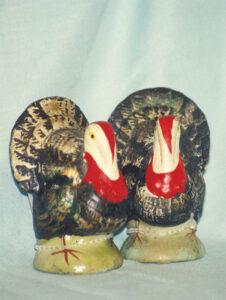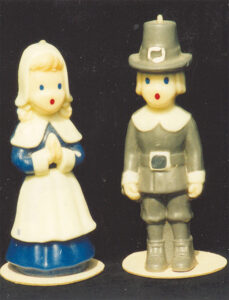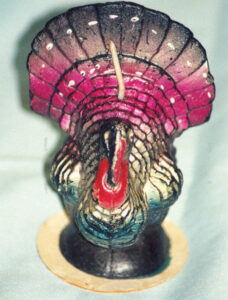 By Robert Reed
By Robert Reed That grand American holiday Thanksgiving had long been celebrated, but it really wasn’t until the 20th century that it came with commercial table decorations.
Before the elegant turkey dinner was mostly fine. A colorful touch direct from the family’s garden harvest might be added.
“Decorations from the earliest (19th century) celebrations were usually homegrown fruits and vegetables used to decorate the dining table or the nearby sideboard,” note Helaine Fendelman and Jeri Schwartz authors of the Official Price Guide to Holiday Collectibles.
“It was not until the early part of the 20th century that manufacturing decorations became widely available to the average homemaker,” they add.
Before that time there was the occasional small silver ornamentation of a figural turkey for the fashionable dining table. Elsewhere the turkey image might appear on silver tableware, or even a cornucopia (horn of plenty). Some leading manufacturers of fancy ware supplied such items by the 1890s but they were relatively expensive certainly not commonplace as Thanksgiving came around.
Early in the 20th century German manufacturers produced a number of Thanksgiving-related items for the marketplace. Frequently they were candy containers in the form of a chicken, duck, turkey or other game bird made of papier-mache. Often such colorful figural containers had metal legs, and some had a metal spring in the neck to provided limited movement in the figure.
Such candy containers varied in size from the typical five to six inches up to a full 16 inches in height. Usually the head of the figural could be removed to gain access to the candy contents.
 Depending on what material was available for manufacturing, such figural designs of the first few decades of the 20th century might also have been made of composition or even celluloid.
Depending on what material was available for manufacturing, such figural designs of the first few decades of the 20th century might also have been made of composition or even celluloid. By the middle of the 1920s wholesale catalogs in the United States were sometimes devoting several pages to special decorations for this particular all-American holiday.
“Thanksgiving assortments are given our special attention,” noted one such catalog in 1924, “and we are sure they will prove most satisfactory.”
Both celluloid and china Kewpie dolls were offered as table decorations for the holiday. The Kewpies could be costumed in a white apron and cook’s hat, dressed as a farmer in overalls, or simply jumping out of a pumpkin. Still others might be dressed in a fringed skirt and holding a pumpkin, carrying a basket of fruit, or clad in gold and green colored crepe paper with a small turkey seal in their hand.
“If so desired we can supply dressed (Kewpie) dolls in all of the above Thanksgiving styles,” assured the wholesale suppliers.
Ironically, while many of the items were clearly marked and marketed within the pages of the catalogs as for the Thanksgiving holiday time has blurred the lines. Today many classic collectibles of that era involving pumpkins and costumed figures are mistakenly placed in the much more popular category of Halloween collectibles.
Additional Thanksgiving table decorations of the 1920s decade include a variety of celluloid turkey figures serving as place card holders. At the other end of the scale were fairly elaborate centerpieces. Among them were the so-called Jack Horner Pies which included a miniature hay wagon filled with hay and drawn by two miniature cows. Variations included the Farmer Pie, and also large pumpkins filled with leaves and fruits topped off by a standing turkey.
There were also a variety of colorful pressed paper offerings ranging from a turkey gobbler to a frying pan, and even a imitation wood butcher’s block complete with turkey gobbler and a meat cleaver.
Retail customers could also order up various turkey designs and fruits made of wax to decorate their Thanksgiving tables. The wax items were accompanied with enforced paper boxes to further hold their arrangement. Additionally there was a limited supply for Thanksgiving nut cups, seals, paper table covers, and paper napkins along with folding crepe paper for further table decorating.
 By the 1940s holiday-minded consumers could find cellophane packages of paper napkins with Thanksgiving motifs. Printed images included the traditional turkey, Pilgrims, American Indians, and various combinations of all three. Two American companies had assumed a major role in producing paper-based decorations of the Thanksgiving holiday.
By the 1940s holiday-minded consumers could find cellophane packages of paper napkins with Thanksgiving motifs. Printed images included the traditional turkey, Pilgrims, American Indians, and various combinations of all three. Two American companies had assumed a major role in producing paper-based decorations of the Thanksgiving holiday. America’s two masters of paper decorations for the holidays were Dennison Manufacturing and the Beistle Company. Dennison was the source of a vast selection of Thanksgiving table decorations. Done in rich tones of the holiday season were all manner of turkeys, Pilgrims, Indians and even stands of wheat. From small seals to cardboard stand-ups the colors were always exceptional. After decades of manufacturing the company was eventually swallowed up through a series of corporate buy-outs and mergers.
Beistle was particularly prolific in the production of so-called honeycombed foldouts of the turkey characters. In addition to the turkey Beistle also sometimes did the honeycombed orange pumpkin or yellow haystack to further complement the table setting. Unlike Dennison, Beistle continued to manufacture delightful holiday decorations of brightly colored paper throughout the 20th century and beyond.
Candy containers enjoyed a renewed popularity on the Thanksgiving table of the 1940s and 1950s. For example L. E. Smith company provided some extraordinary two-piece turkey shaped candy containers. Advertised as turkey candy box or turkey candy bowl, they stood seven inches tall. In the 1970s the firm was sold to Libbey Glass in Toledo, Ohio before being acquired by other companies.
Some of the most resplendent Thanksgiving table decorations of those same 1940s and 1950s decades came in the form of candles from the Gurley Novelty Company. The firm produced an entire line of holiday candles during those years including selections marketed particularly for the Thanksgiving holiday. Their Thanksgiving line included individual turkeys in various shades of color, Pilgrims, Indians, and related objects. The male Pilgrim varied in that it was sometimes shown armed with a musket, and sometimes not armed. The actual size of the objects varied from time to time.
Like those for other holidays, the Thanksgiving type candles from Gurley were sold individually or sometimes in boxed sets. Individual candles were readily identified by the cardboard tag attached to the underside of their base. The tag itself offered the selling price, the company name (which was later changed to Gurley Candles), and brief message of caution. While the Gurley-warning itself evolved over the years, typically it cautioned that burning could deform the figures and otherwise leave a mess. Fortunately lots of people chose not to use them as candles at all but simply as table decorations.
Once stocked in vast numbers across the nation in Woolworth’s and other variety stores, such Thanksgiving candles are quite collectible today. Such candles may be “relatively easy to find but condition and vibrant color are important,” note John and Sandra Thomas the co-authors of Thanksgiving And Turkey Collectibles. They further suggest that the male and female Native American Indian figures “are less frequently found” and their fragile Indian head feather components were “prone to snap off” at some point in their shelf life.
Tavern Novelty Candles also made various Thanksgiving candles as late as the 1960s including a box set of four figural Pilgrim candles. Other makers during that period included W & F Manufacturing Company.
By the 1960s plastic turkey candy containers were being produced in Hong Kong for the American market. Plastic candy containers in the form of a turkey were also being made by the E. Rosen company in various colors plus solid white.
Collectors today look for all the “decorative turkey accouterments” of the past to highlight their Thanksgiving table according Thomas and Thomas. Initially there is glass, pottery and papier-mache. However they add watch as well for “paper displays, candles, figurines, centerpieces, and other things” of grand Thanksgivings past.
Recommended reading: Thanksgiving And Turkey Collectibles, Then & Now by John Thomas and Sandra Thomas (Schiffer Publishing).















Follow Us